
continued from Skip en Sudamérica - Part 1
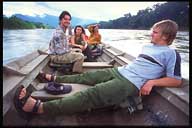 |
After having to go back to New Zealand for my father's funeral, getting back to La Paz seemed a whole lot more painful than going home despite everything happening very smoothly. It started off with a flight of about 11 hours from Auckland to Buenos Aires where I had to spend the night before flying on to Santa Cruz, Bolivia the next morning. I then took an overnight bus from Santa Cruz to La Paz and arrived in La Paz feeling like I'd had three days of continuous traveling and three straight nights of very bad sleep.
Revisiting Buenos
Aires, even if only for half a day was quite interesting as it gave me
a slightly different perspective on the place after having more of South
America to compare it with. It definitely has a very European feel and
is damn expensive. There must be some great things to see in Argentina,
particularly in the far south, but a country like Bolivia is so much better
value for money with tons of great things to do at very reasonable prices.
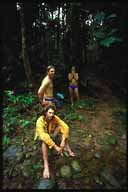 |
Eager to get back on the road again, I hung out in La Paz just on the Sunday waiting for businesses to open on Monday. The following day I booked a place on a mountain bike ride from La Cumbre, near La Paz, down to Coroico with Gravity Assisted Mountain Biking. At about US$50, this was a fairly expensive activity but it promised to be a thrill. The ride starts at an altitude of about 4,700 m (15,420 ft) and drops 3,500 m in a 62 km stretch of twisting road, often referred to as The World's Most Dangerous Road.
The first stretch of road was sealed and took us screaming down through icy alpine terrain. Having hardly ridden a bike for 15 years, I was at first a little hesitant to release my firm grip on the brakes but soon felt fairly much at ease and was later able to handle the much rougher unsealed road that followed without too much problem.
I did the mountain bike thing partly to avoid the bus trip down the dangerous road and after cycling down it was pleased I'd made that choice. In many places the road is a single lane dirt track cut into the cliff face. On the outside it often plummets vertically for several hundred, if not a thousand metres or more. Picture a crumbling dirt edge, frequent land slips, heavy vehicles forced to drive within a tyre width of the edge and it's easy to imagine the many vehicles and lives lost on the road.
 |
As we dropped in altitude
the temperature began to increase and the vegetation thicken until at
the end we found ourselves in the rain forest and tropical heat of the
Amazon Basin - an amazing transformation for a bike ride of just a few
hours.
I stayed a couple of nights in Coroico, a very pretty little town set
on a hillside offering spectacular views of tropical valley below and
the icy peaks far above. The bus ride on to Rurrenabaque (or Rurre), further
into the Amazon Basin, was the worst yet of my trip. Parts of the road
seemed just as bad as the notorious road to Coroico but the darkness for
most of the trip concealed the condition of the track and alleviated anxieties
considerably. Conditions during the 16 hour bus ride weren't good. The
road was rough, the bus crowded and I spent most of the night in a quiet
tussle with locals to retain some leg room and acquire a vaguely comfortable
posture.
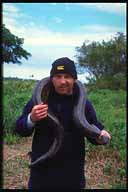 |
On arrival in Rurre, I was fucked but went to check out the tours. I'd been sitting next to Martin, a German, on the bus and we booked together on a tour comprising two days in the jungle and three days in the pampas. After relaxing for a day in the tropical heat of Rurre, we headed off to the jungle the next day with two Aussis, Gavin and Steve, a Croatian girl, Bridgitte, a Dutch couple and a French couple. The trip started with a four or five hour ride up the Rio Beni in an outboard powered hollowed-out-log type contraption. The scenery was pleasant but our arses became sore after several hours on the hard seats and we were pleased to finally arrive at the jungle camp.
Expecting to be attacked by insects we immediately covered ourselves with clothing and slapped repellent over exposed hands, necks and faces. Wearing long clothing in that heat was not entirely comfortable but the heat was not as oppressive as I had experienced in the Pantanal in Brazil.
That night we had a pleasant walk through the jungle by torch light. We saw a few monkeys and giant spiders but nothing spectacular. The mosquitos and bugs in general seem to be fickle in their activity. While other groups were plagued by the things and got badly bitten, we seemed to escape the worst and got only a few bites.
 |
The next day we went on quite a long walk through the jungle. The vegetation was pretty thick and although the place is probably swarming with animals, we saw just a few groups of monkeys. They seem to be very wary of human intruders and in the views we got of them, they were high in the tree tops swinging from limb to limb with incredible agility or leaping more clumsily between tree canopies and landing on each one with a great splash that sent a shower of leaves drifting down to the forest floor. Of perhaps more interest were the many medicinal plants we were shown. It is hard not be a little skeptical about the efficacy of all these medicines but we were shown plants which supposedly act as preventatives or cures for malaria, yellow fever, cancer, snake bites, cholera and a variety of other ailments.
The jungle seemed to be full of ants of many different types. Some were tiny but capable of making you very ill. The largest, the veinticuatros ('24' in Spanish) were up to an inch long and a bite from one of them supposedly gives you major local paralysis and leaves you very sick for 24 hours.
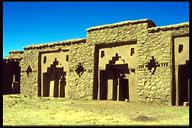 |
In the afternoon, we motored back down the river to Rurre where we spent the night before heading off to the pampas the following day. After a road trip of three or four hours heading through and beyond Santa Rosa, we reached a small river where we transferred to a boat. The weather was good but patchy cloud cover moderated the temperature and it seemed ideal for viewing wildlife along the river.
During the three hour boat trip to our camp, we motored slowly along the river - little more than 10 metres wide. Crocodiles up to about three metres long were everywhere and many had crawled out onto the muddy banks to bask in the sun. Capybaras, the rat related water pigs the size of sheep sat nonchalantly on the river bank as we motored slowly past.
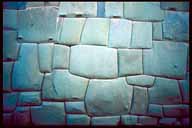 |
At every twist of the river a new vista with several large birds was revealed - herons, egrets, cormorants, storks, spoonbills and lots of others I can't put a name to. The river was full of turtles, many perched on dead trees poking out of the water. There must have been tons of fish beneath the water providing food for many of these animals but the water was a muddy brown and we saw only the occasional splash made by them.
Much bigger splashes were made by groups of fresh water dolphins. They were hard to get a good look at and impossible to photograph but seemed a bizarre thing to see in a muddy stream thousands of kilometres from the sea. In the rainy season the water level rises perhaps five metres and huge areas of the pampas become a massive lake. At these times when the water is expansive and much clearer, I imagine the dolphins have a much better time.
 |
In the evening we did the crocodile catching thing. We cruised slowly along the river in the dark looking for crocodiles by torch light. After missing a couple, our guide, Samuel lassoed one and hauled it on board. After a bit of thrashing, the croc's mouth was lashed and we passed the thing, perhaps 20 kg in weight, around amongst us and took a few snaps before releasing him.
During our first night at the pampas camp something strange happened with the weather. After going to bed in steamy tropical heat wearing almost nothing, I became aware of a strong wind in the trees around the camp. Wafts of cool, refreshing air washed over us and felt good at first. During the night, the wind continued to blow hard and it became progressively colder. I awoke several times to put on more clothes and by the morning had five layers of clothing on and still was not entirely warm. Some of the others on the trip had left much of their warm clothing in Rurre and were seriously short of things to wear or sleeping bags. Fortunately, I had all my stuff with me and was able to keep myself warm enough but it was a rude shock to all of us to end up shivering when we'd expected to be sweating.
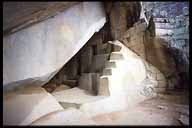 |
The following day was cold and fairly miserable with intermittent rain. Late in the morning we fished in the river beside the camp site for piranhas. These things do grow to a decent size but the little beasts there were only about 3 inches long. As would be expected for someone with my lack of fishing skill, I caught none but others caught several which we later ate. I think they were quite tasty but so damn small that there was hardly any meat on them.
In the afternoon we cruised up the river in constant drizzle. There were animals about but many of them, including the mosquitos obviously didn't like the cold weather and certainly weren't out basking in the sun.
 |
That night the guides told us stories of Jaguars and giant Anacondas - probably half bullshit but they sounded good. I seem to remember reading that a rich American had offered a huge cash prize for a snake in excess of 20 feet. According to our guides, they had seen an 8 metre snake, knew of a 10 metre one that had been sighted in the area and were sure that they grow as large as 15 metres. These big ones supposedly live deep in large lagoons, perhaps burrowing into mud holes at the bottom of the lagoon and have skin so tough and thick that no knife can cut them - dynamite is the best way to kill them. Oh yeah, and they eat cows.
So, the next day we
went looking for Anacondas although it seemed likely that they would be
difficult to find in the cold conditions. The area where we searched was
an expanse of grass, partially grazed by horses and cattle (Anaconda food),
and broken up by ponds and partially dried up streams. After some searching
we left the guides to go off on their own to "get the fucking snake!".
In the mean time we walked around and collected toadstools in the hope
that they were magic mushrooms (they subsequently turned out to have no
effect).
 |
Just as were starting to get into the thick of the mushrooms, we heard a lot of whistling and yelling and headed back to where the guides had left us. They'd found two of the critters. The little Anaconda was perhaps a metre long and not at all impressive beside his big brother, maybe three metres long (but the photos might make a liar of me). He'd been eating and had a bulge in his gut at which point his girth was about that of a 150 pound weakling's flexed bicep.
This eating apparently made him somewhat lethargic. If that didn't, having his neck throttled by a bunch of silly Gringos probably did. They're not venomous but do bite so a good grip on the neck is a sensible idea. We all took photos of the thing draped around our necks and then group photos - the poor bastard. The only other notable thing about the snake was the stink - something between fish and rotten meat, and it seems to stay with you for while after handling it.
 |
Back in Rurre, we spent a day relaxing and then almost another day waiting for the delayed flight back to La Paz. Flying in this twin prop thing painted in camouflage greens didn't make me all that happy but we got some good views on the way, particularly where we crossed the mountain range at the edge of the Altiplano and then flew over La Paz.
I had two more nights
in La Paz before farewelling it. On the last night I went out with the
two Aussis and some others. La Paz isn't a great place for night life
but we certainly checked out almost everything on offer. After the late
night I was doubtful whether I'd be able to wake in time to catch the
bus but managed to haul myself out of bed at seven and was soon on the
bus to Copacabana. The highway from La Paz up to El Alto, the city on
the canyon rim above La Paz, was lined with police with tear gas guns
and I was kind of pissed off that I never got to see them in use in the
more than two weeks I'd stayed in La Paz.
 |
I stopped for two
nights in Copacabana, a town at the southern end of Lake Titicaca (not
the beach in Rio de Janeiro). From there I did a day tour to the Isla
del Sol and Isla de la Luna, scared islands of the Incas. The ruins on
the islands are very much ruined but the views of the lake and surrounding
mountains are pretty cool. The original temples adorned with tons of gold
and silver must have been an incredible sight before the Spanish looted
and destroyed them but today there's not a lot left to see.
After crossing into
Perú, I decided not to stay in the town of Puno and continued on
an overnight bus to Cuzco. The bus trip turned out to be much quicker
than I expected and resulted in me arriving in Cuzco at about 3 am - a
fucking inconvenient time. It was too early to wait for morning and hard
to find somewhere to stay so I got a hotel for the brief night and changed
the next morning to somewhere more central that had been recommended to
me.
 |
Cuzco is one of the most popular tourist destinations on the continent. It's similar to many colonial cities but has the added historical interest of being the former capital of the Inca Empire. The Incas were big on their stone buildings and many of the original Inca stone foundations can still be seen around the city. The quality of workmanship is incredible. In some of the more impressive stone walls, huge blocks of stone have been crafted to key into each other like a jigsaw puzzle. Where there's small gaps between them you know these must have been caused earthquakes because the workmanship is just incredible. The curved faces of the stone blocks are lovely things to gaze at and wonder at the work which must have gone into making them.
Cuzco is such a big
tourist destination that the locals have become far more proficient at
milking money of foreigners than anywhere else I'd been in South America.
There's loads of souvenir shops, travel agencies, internet cafés
packed with Gringos and restaurants to cater to our delicate palates.
Cuzco's popularity
is due largely to the nearby Inca Trail and Machu Picchu - the biggest
tourist attraction on the continent. I would head off there soon but had
to hang out for a couple of days to see if my Aussi mates would show up.
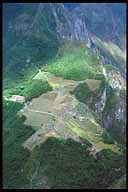 |
There are several
ways to get to Machu Picchu, the so called Lost City of the Incas. Although
the location is somewhat remote, it is a huge money spinner for Perú and
the Peruvians have made sure that everyone can get there. The Inca Trail
is a four day hike which ends at Machu Picchu and although it's quite
a tough way of getting there, there are thousands of people doing it as
well as thousands more who do it as a less strenuous day trip from Cuzco.
It is currently possible to do the Inca Trail by yourself, carrying your own food and camping equipment but I elected to do it with an agency which provides all the necessary camping equipment, food and guides. I left from Cuzco with a group of 11 others early one morning on a three hour bus ride to the beginning of the trail. Many in the group had hired porters to carry their backpacks. I decided to carry my own and not to leave any of my belongings that weren't necessary for the trail behind in Cuzco. On the first day we walked for about six hours along a trail which climbed a bit but wasn't particularly strenuous. The weather started off generally fine with patches of cloud but turned more and more miserable during the afternoon with quite a bit of rain. At the camp that night it continued to rain but the tents were quite good and we stayed reasonably dry. During the day, we'd seen the first Inca ruins of the trail and got an introduction to Inca history from our guide, Mauricio.
 |
Although an extensive and impressive empire in its day, it existed for only a brief period in history and is not particularly ancient. Most of the ruins we saw began construction about 1400 and were little more than 100 years old when the Spaniards arrived in the area in the 1530's and began their pillaging and destruction. Fortunately, the valleys of the Inca Trail were never discovered by the Spanish and therefore, the ruins in them remain reasonably intact. However, on the arrival of the Conquistadors the Incas deserted these settlements and fled to the jungle of the Amazon Basin taking the gold and silver from the temples with them. Cuzco was the capital of the Inca empire and the Spaniards got all there was to get there but Machu Picchu was the most important religious centre for the Incas and must have housed many riches. It seems that these may remain undiscovered and the search continues today for lost Inca cities in the jungles of Perú.
 |
The second day of
the Inca Trail is supposedly the hardest as it involves a climb over the
highest pass on the trail at 4,200 metres (13,780 ft). As on the first
day, the weather started off reasonably but soon deteriorated and at our
camp that night, just before the second pass at 3,860 metres (12,660 ft),
the weather was awful. At the camp the tents were set up but we took shelter
from the wind, rain, sleet and snow in a cave for a while before retreating
to the tents. In the tents things were looking pretty grim as darkness
set in. The rain had turned the camp site into a bog, water began coming
through the tent floors and the strong wind was driving snow into the
tents and half collapsing them at times. Staying dry and warm was a battle
for a while but fortunately the weather began to ease after a couple of
hours and we ended up having a damp but reasonable night.
The next morning it was still heavily overcast but sufficiently clear to give us a magnificent view of the surrounding mountains blanketed in fresh snow. The previous day I'd foolishly done a lot of running down the steep descents and my knees were hurting quite a bit. The third day involved a lot of steep descents down thousands of steps which made my knees ache all the more. We didn't get a lot of rain that day but for much of the time the mist was so thick that we got no views and were unable to see some nearby ruins. Our camp on the third night was on an Inca terrace which provided magnificent views of the Urubamba valley below when the swirling clouds permitted.
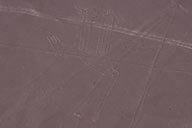 |
Only two hours away
from Machu Picchu this was the most congested point on the trail. Tents
occupied every available space and at some points, the stench of humanity
was overpowering. With hundreds of trekkers and associated guides and
porters passing every day, the pressure on facilities is obvious. Proper
toilets are almost non existent and for most just consist of a very shallow
hole dug in the ground. A departure from the trail at any point requires
footsteps to be chosen carefully and often results in a rude surprise.
On the final day we
were awoken at 3.30 am and left camp an hour later, walking in the dark
by torch light for at least an hour. We waited briefly at the Sun Gate,
an hour away from Machu Picchu and got our first views of the ruins there
as the daylight began to reveal the landscape. Those familiar photos of
Machu Picchu that everyone must have seen tell it pretty much like it
is. The ruins aren't incredibly grand or extensive but the mountainside
setting with peaks above and valley plunging below is magnificent. On
arrival we gazed down on the city from the postcard vantage point for
a while before depositing our backpacks and heading off on a two hour
guided tour of the ruins.
 |
Because the Spaniards were never there, there's lots of nifty things to see, particularly in the temples. The altars, sundials, compasses and rock formations in the shape of condors and pumas are pretty cool. There's all sorts of stuff I could waffle on about but you're much better off digging out an old National Geographic or something. After the guided tour we had plenty of time to wander around the ruins at leisure but many in the group felt exhausted from the days of walking and the early start. By this stage my knees and calves ached with every step but I made myself wander around to see parts of the ruins again and then decided to climb to the top of the sugarloaf peak, Huayna Picchu, which rises above the ruins. This climb was pretty steep and tough for an old man in my condition but the view from the top made all the pain worth while. At the end of the day we jumped on a train at Aguas Calientes, a small town near the ruins and were back in Cuzco by late evening.
 |
Cuzco is a cool place to hang out for a while and although I was getting concerned about how little time I had left in South America, I ended up staying in Cuzco for over a week. There's lots to see in town and plenty of ruins not far from the city. And, the food and beer's great, the internet cafes have fast connections and you can sit in the plaza all day watching the world go by or watch free movies to your heart's content in Gringo bars. During the last few days of my stay there the locals had big independence celebrations in the plaza every morning. These were impressive but apparently somewhat subdued this year because the people were unhappy about the political situation
and violence occurring
in other cities. The next day I would head for Arequipa, site of recent
demonstrations associated with Fujimori's swearing in for a third term
after supposedly dodgey elections. In Lima six had died in very recent
demonstrations but I wouldn't get there for a few days and hoped things
would have eased by then.
 |
Leaving Cuzco was
kind of sad but I badly needed to move on and get a little closer to my
final destination. Little into the journey on a night bus to Arequipa
a kid in the seat behind me decided to crap his pants and stank out the
whole bus terribly. The locals protested "but he's a child not a baby!".
The shit was soon disposed of but the road was rough and I got little
sleep. Arequipa, Perú's second largest city has a relaxed small town feel.
There I visited the Santa Catalina monastery where I gazed at the decaying
16th and 17th century art works and the medieval living conditions and
left the next day on a tour to the Colca Canyon - perhaps the world's
deepest canyon where I particularly wanted to see the condors.
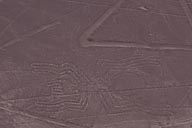 |
After a four hour
drive from Arequipa over a 4,800 metre (15,750 ft) pass we arrived at
Chivay, a small town in the Colca Valley where we stayed for the night.
That day we'd seen loads of the usual herds of llamas and alpacas but
also their wild cousin, the vincuna. At Chivay we bathed at the hot springs
and endured a musical performance at a restaurant that night where most
people were dragged up to dance with the traditional dancers. After a
frosty early morning start the next day we stopped at several villages
along the Colca Valley, most of which had been ruined by relatively recent
earthquakes. Many of the locals had dressed themselves and their animals
in spectacular fashion and made a bizarre sight as they posed in the early
morning light in front of their churches for tourist photos. Mums, kids,
baby llamas, baby alpacas, lambs, calves and eagles, all ridiculously
decorated looked sort of pitiful and I refrained from taking any photos
of them.
At 8.30 am we arrived at Cruz del Condor from where you get a magnificent
view of the deep canyon. There we sat with a throng of other tourists
waiting for the big birds to appear. After about 15 minutes the first
one was spotted cruising close to the sunlit canyon walls far below. As
the early morning sun warmed things, more condors appeared and their gliding
carried them higher up the walls of the canyon. With wing spans to over
three metres they are big but they seldom came very close to us which
made it hard to appreciate their size against the huge canyon backdrop.
The condors seemed to only hang around for about half an hour and I was
left a little disappointed that they didn't come a little closer and stay
a little longer.
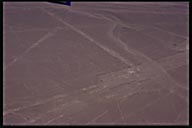 |
Back in Arequipa after
a night of too many beers and cigarettes, I caught a late bus to Nazca
where I arrived at about 6 am, keen to see the Nazca Lines, the huge geoglyphs
in the desert. The morning revealed itself to be very hazy and flights
over the lines seemed impossible. I booked the flight but had to wait
for better weather and occupied myself that afternoon with a tour to the
ancient cemetery at Chauchilla (Cementerio de Chauchilla).
I'd seen photos and TV documentaries on the cemetery but it turned out
to be quite a bit different from what I expected. The tombs are beneath
the desert sand but during the pillaging of grave robbers in the relatively
recent past, the contents of the tombs were hauled out and left strewn
about the desert. The sand is still littered with human bones, fragments
of garments and bundles of cotton that were used to stuff the corpses
but the mummified heads and bodies have now been collected up and placed
back in the tombs. This seems to have been done in a fairly crude way
but at least the remains should last for a few years longer than they
would have done exposed directly to the sun, wind and sand.
 |
The mummified bodies seem to have remained reasonably well preserved for 1000 or 1500 years but deteriorate relatively rapidly after sitting exposed in the desert for 10 or 15 years. Still, many of the skulls have skin attached to them, some with masses of incredibly long hair. Apparently the robbers didn't discover all the tombs so at least there's potential to properly excavate and preserve some of this stuff in the future. The stuff that's visible now is so poorly cared for that I can't imagine there'll be anything to see in a few decades.
The next day the sky
was still a little hazy but certainly an improvement on the previous day.
After hanging around at the airport for a while I was eventually buzzing
skywards in a little Cessna. The motion of the plane was anything but
steady but felt OK to me. The woman behind me obviously didn't agree and
as one who usually takes no pleasure whatsoever in flying, I couldn't
help feeling a little smug at my relative comfort. After whizzing over
the desert for five or 10 minutes, we made a circuit over the first figure,
the whale. I struggled to see it at first but they were all pretty clear
once the pilot pointed them out. After the whale, we saw the triangles,
the trapezoids, the astronaut (but how did they know?!), the dog, the
monkey, the condor, the humming bird, the spider, the alcatraz, the parrot,
the tree and the hands. There's lots of straight lines too but the figures
are of course much more impressive. Some of them really look very cool
but the views of each one only lasted for perhaps 10 or 20 seconds spent
squinting through my camera's viewfinder. I hope like hell the photos
are OK. I didn't get a lot on the history or significance of the lines
- I'll need to read up on that.
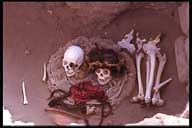 |
The bus trip the next
day, north up the coast to Lima wasn't a very pretty one. The scene is
typically one of barren, sandy desert with a smog like haze blocking out
any direct sunlight. Although well into the tropics, cold ocean currents
keep this coastal area cool and dry and make it an arid and most unappealing
part of the continent.
Then, imagine a huge, polluted city of eight million plus people in this landscape and you have Lima. Many people loathe Lima, it's probably just there to prove again that there is no god. I know so much about Lima because I stayed there one night and that was quite enough. After just a few hours in Lima, I happened to bump into Steve, an Aussi I'd spent some time with in Bolivia and Cuzco. I was ready to get out of Lima so I jumped on a bus with Steve to Huaraz. Traveling during the day, the coast north of Lima was similar to that further south but the sun was doing its best to blast through the haze and the greeny-blue ocean looked sort of pretty. A few offshore rocks and islands looked interesting but plastic bags and other floating rubbish spoiled the aesthetic for miles up the coast from Lima.
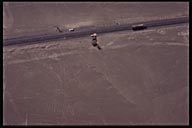 |
After a long day in
the bus from Lima, Steve and I arrived in Huaraz, a relaxed little town
set at the foot of a snow capped mountain range - the Cordillera Blanca.
This place seemed a world away from the mayhem of Lima and the arid desert
of the Pacific coast. Huaraz is a great base from which to do treks in
the mountains but both Steve and I were feeling the pressure of time,
the urge to continue north, and we elected to do only a day trip from
Huaraz rather than a more lengthy trek of several days. The trip north
along the Rio Santa valley was pretty but not spectacular. We stopped
for some time in the town of Yungay, completely wiped out and buried by
an avalanche resulting from an earthquake in 1970 and continued on to
Lagunas Llanganuco, some pretty lakes set amongst the mountains. Huascaran,
at 6,768 metres (22,200 ft), the highest mountain in Perú towered above
us but was largely concealed by cloud.
That evening we discovered there were only night buses heading further
north and were prompted by time and the unseasonable rain to jump on a
bus to Trujillo.
go
to Skip en Sudamérica
- Part 3
© 2001 ianskipworth.com